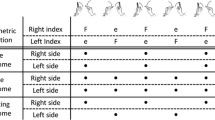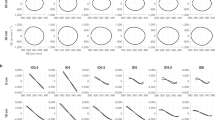Abstract
The present study investigates the coordination between two people oscillating handheld pendulums, with a special emphasis on the influence of the mechanical properties of the effector systems involved. The first part of the study is an experiment in which eight pairs of participants are asked to coordinate the oscillation of their pendulum with the other participant’s in an in-phase or antiphase fashion. Two types of pendulums, A and B, having different resonance frequencies (Freq A=0.98 Hz and Freq B=0.64 Hz), were used in different experimental combinations. Results confirm that the preferred frequencies produced by participants while manipulating each pendulum individually were close to the resonance frequencies of the pendulums. In their attempt to synchronize with one another, participants met at common frequencies that were influenced by the mechanical properties of the two pendulums involved. In agreement with previous studies, both the variability of the behavior and the shift in the intended relative phase were found to depend on the task-effector asymmetry, i.e., the difference between the mechanical properties of the effector systems involved. In the second part of the study, we propose a model to account for these results. The model consists of two cross-coupled neuro-mechanical units, each composed of a neural oscillator driving a wrist-pendulum system. Taken individually, each unit reproduced the natural tendency of the participants to freely oscillate a pendulum close to its resonance frequency. When cross-coupled through the vision of the pendulum of the other unit, the two units entrain each other and meet at a common frequency influenced by the mechanical properties of the two pendulums involved. The ability of the proposed model to address the other effects observed as a function of the different conditions of the pendulum and intended mode of coordination is discussed.
Similar content being viewed by others
References
Amazeen PG, Schmidt RC, Turvey MT (1995) Frequency detuning of the phase entrainment dynamics of visually coupled rhythmic movements. Biol Cybern 72:511–518
Beek PJ, Peper CE, Daffertshofer A (2002) Modeling rhythmic interlimb coordination: beyond the Haken–Kelso–Bunz model. Brain Cogn 48:149–165
Bingham GP (1995) The role of perception in timing: feedback control in motor programming and task dynamics. In: Covey E, Hawkins H, McMullen T, Port R (eds) Neural representation of temporal patterns. Plenum, New York
Bingham GP (2001) A perceptually driven dynamical model of rhythmic limb movement and bimanual coordination. In: Proceedings of the 23rd annual conference of the cognitive science society. Lawrence Erlbaum Associates, Mahwah
Bingham GP (2004) A perceptually driven dynamical model of bimanual rhythmic movement (and phase perception). Ecol Psychol 16:45–53
Bingham GP, Schmidt RC, Turvey MT, Rosenblum LD (1991) Task dynamics and resource dynamics in the assembly of a coordinated rhythmic activity. J Exp Psychol Hum Percept Perform 17:359–381
Bingham GP, Schmidt, RC, Zaal FT (1999) Visual perception of the relative phasing of human limb movements. Percept Psychophys 61:246–258
Bingham GP, Zaal FT, Shull JA, Collins DR (2001) The effect of on the visual perception of relative phase and phase variability of two oscillating objects. Exp Brain Res 136:543–552
Bressloff PC (1995) Average firing rate of a neural network with dynamical disorder. J Phys A Math Gen 28:2457–2469
Carson RG, Riek S, Bawa P (1999) Electromyographic activity, H-reflex modulation, and corticospinal input to forearm motoneurones during active and passive rhythmic movements. Hum Mov Sci 18:307–343
Carson RG, Riek S, Mackey DC, Meichenbaum DP, Willms K, Forner M, Byblow WD (2004) Excitability changes in human forearm corticospinal projections and spinal reflex pathways during rhythmic voluntary movement of the opposite limb. J Physiol 560:929–940
Cattaert D, Semjen A, Summers JJ (1999) Simulating a neural cross-talk model for between-hand interference during bimanual circle drawing. Biol Cybern 81:343–358
Challis J (1999) A procedure for the automatic determination of filter cut-off frequency for the processing of biomechanical data. J Appl Biomech 15:303–317
Collins DR, Sternad D, Turvey MT (1996) An experimental note on defining frequency competition in intersegmental coordination dynamics. J Mot Behav 28:299–303
Dempster W (1955) Space requirements of the seated operator. WADC Technical Report, 55–159, Report released to the Office of technical Services. U.S. Dept. Of Commerce, Washington
Fisher NI (1993) Statistical analysis of circular data. Cambridge University Press, Cambridge
Fitzhugh R (1957) Mathematical models of excitation and propagation in nerve. In: Schwan HP (eds) Biological engineering. McGraw-Hill, New York
Goldfield EC, Kay BA, Warren WH (1993) Infant bouncing: the assembly and tuning of action systems. Child Dev 64:1128–1142
Goodman L, Riley MA, Mitra S, Turvey MT (2000) Advantages of rhythmic movements at resonance: minimal active degrees of freedom, minimal noise, and maximal predictability. J Mot Behav 32:3–8
Hatsopoulos NG (1996) Coupling the neural and physical dynamics in rhythmic movements. Neural Comput 8:567–581
Hatsopoulos NG, Warren WH (1996) Resonance tuning in rhythmic arm movements. J Mot Behav 28:3–14
Jantzen KJ, Steinberg FL, Kelso JA (2004) Brain networks underlying human timing behavior are influenced by prior context. Proc Natl Acad Sci USA 101:6815–6820
Jirsa VK, Haken H (1997) A deviation of a macroscopic field theory of the brain from the quasi-microscopic neural dynamics. Physica D 99:503–526
Kelso J (1981) On the oscillatory basis of movement. Bull Psychon Soc 18:63
Kilner JM, Paulignan Y, Blakemore SJ (2003) An interference effect of observed biological movement on action. Curr Biol 13:522–525
Kugler PN, Turvey MT (1987) Information, natural law, and the self-assembly of rhythmic movement. Erlbaum, Hillsdale
Latash ML (1992) Virtual trajectories, joint stiffness, and changes in the limb natural frequency during single-joint oscillatory movements. Neuroscience 49:209–220
Liu Y-H, Wang X-J (2001) Spike-frequency adaptation of a generalized leaky integrate-and-fire model neuron. J Comput Neurosci 10:25–45
Nagumo J, Arimoto S, Yoshizawa S (1962) An active pulse transmission line simulating nerve axon. Proc Inst Radio Eng 50:2061–2070
Oullier O, de Guzman GC, Jantzen KJ, Kelso JAS (2003) On context dependence of behavioral variability in interpersonal coordination. Int J Comput Sci Sport 2:126–128
Peper CL, Beek PJ, Daffertshofer A (2000) Considerations regarding a comprehensive model of (poly)rhythmic movement. In: Desain P, Windsor L (eds) Rhythm perception and production. Swets and Zeitlinger, Lisse
Peper CE, Nooij SA, Van Soest AJ (2004a) Mass perturbation of a body segment: 2. Effects on interlimb coordination. J Mot Behav 36:425–441
Peper CL, Ridderikhoff A, Daffertshofer A, Beek PJ (2004b) Explanatory limitations of the HKB model: incentives for a two-tiered model of rhythmic interlimb coordination. Hum Mov Sci 23:673–697
de Rugy A, Sternad D (2003) Interaction between discrete and rhythmic movements: reaction time and phase of discrete movement initiation during oscillatory movements. Brain Res 994:160–174
de Rugy A, Wei K, Muller H, Sternad D (2003) Actively tracking ‘passive’ stability in a ball bouncing task. Brain Res 982:64–78
Russell DM, Sternad D (2001) Sinusoidal visuomotor tracking: intermittent servo-control or coupled oscillations? J Mot Behav 33:329–349
Schmidt RC, O’Brien B (1997) Evaluating the dynamics of unintended interpersonal coordination. Ecol Psychol 9:189–206
Schmidt RC, Turvey MT (1994) Phase-entrainment dynamics of visually coupled rhythmic movements. Biol Cybern 70:369–376
Schmidt RC, Carello C, Turvey MT (1990) Phase transitions and critical fluctuations in the visual coordination of rhythmic movements between people. J Exp Psychol Hum Percept Perform 16:227–247
Schmidt RC, Beek PJ, Treffner PJ, Turvey MT (1991) Dynamical substructure of coordinated rhythmic movements. J Exp Psychol Hum Percept Perform 17:635–651
Schmidt RC, Shaw BK, Turvey MT (1993) Coupling dynamics in interlimb coordination. J Exp Psychol Hum Percept Perform 19:397–415
Schmidt RC, Bienvenu M, Fitzpatrick PA, Amazeen PG (1998) A comparison of intra- and interpersonal interlimb coordination: coordination breakdowns and coupling strength. J Exp Psychol Hum Percept Perform 24:884–900
Sternad D, Turvey MT, Schmidt RC (1992) Average phase difference theory and 1:1 phase entrainment in interlimb coordination. Biol Cybern 67:223–231
Sternad D, Collins D, Turvey MT (1995) The detuning factor in the dynamics of interlimb rhythmic coordination. Biol Cybern 73:27–35
Sternad D, Amazeen EL, Turvey MT (1996) Diffusive, synaptic, and synergetic coupling: an evaluation through in-phase and anti-phase rhythmic movements. J Mot Behav 28:255–269
Sternad D, Saltzman EL, Turvey MT (1998) Interlimb coupling in a simple serial behavior: a task dynamic approach. Hum Mov Sci 17:393–433
Strogatz SH (1994) Nonlinear dynamics and chaos: with applications to physics, biology, chemistry, and engineering. Addison-Wesley, Reading
Taga G (1995a) A model of the neuro-musculo-skeletal system for human locomotion. I. Emergence of basic gait. Biol Cybern 73:97–111
Taga G (1995b) A model of the neuro-musculo-skeletal system for human locomotion. II Real-time adaptability under various constraints. Biol Cybern 73:113–121
Taga G (1998) A model of the neuro-musculo-skeletal system for anticipatory adjustment of human locomotion during obstacle avoidance. Biol Cybern 78:9–17
Temprado J-J, Laurent M (2004) Attentional load associated with performing and stabilizing a between-persons coordination of rhythmic limb movements. Acta Psychol (Amst) 115:1–16
Temprado J-J, Swinnen SP, Carson RG, Tourment A, Laurent M (2003) Interaction of directional, neuromuscular and egocentric constraints on the stability of preferred bimanual coordination patterns. Hum Mov Sci 22:339–363
Treffner P, Turvey MT (1995) Handedness and asymmetric dynamics of bimanual rhythmic coordination. J Exp Psychol Hum Percept Perform 21:318–333
Treffner PJ, Turvey MT (1996) Symmetry, broken symmetry, and handedness in bimanual coordination dynamics. Exp Brain Res 107:463–478
Turvey MT, Rosenblum LD, Schmidt RC, Kugler PN (1986) Fluctuations and phase symmetry in coordinated rhythmic movements. J Exp Psychol Hum Percept Perform 12:564–583
Van der Pol B (1926) On “relaxation oscillations”. Phil Mag J Sci 2:978–992
Van Soest AJ, Peper CE, Selles RW (2004) Mass perturbation of a body segment: 1. Effects on segment dynamics. J Mot Behav 36: 419–424
Von Holst E (1973) Relative coordination as a phenomenon and as a method of analysis of central nervous system function. In: Marin R (eds) The behavioral physiology of animal and man. The collected papers of Erics Von Holst, vol 1. University of Miami Press, Coral Gables, pp 1–1
Williamson MM (1998) Neural control of rhythmic arm movements. Neural Netw 11:1379–1394
Williamson MM (1999) Robot arm control exploiting natural dynamics. Unpublished PhD, MIT, Cambridge
Williamson MM (2003) Oscillators and crank turning: exploiting natural dynamics with a humanoid robot arm. Phil Trans A Math Phys Eng Sci 361:2207–2223
Wimmers RH, Beek PJ, van Wieringen PCW (1992) Phase transitions in rhythmic tracking movements: a case of unilateral coupling. Hum Mov Sci 11:217–220
Wing AM, Kristofferson AB (1973) Response delays and the timing of discrete motor responses. Percept Psychophys 14:5–12
Yamanishi J, Kawato M, Suzuki R (1980) Two coupled oscillators as a model for the coordinated finger tapping by both hands. Biol Cybern 37:219–225
Yu H, Russell DM, Sternad D (2003) Task-effector asymmetries in a rhythmic continuation task. J Exp Psychol Hum Percept Perform 29:616–630
Zaal FT, Bingham GP, Schmidt RC (2000) Visual perception of mean relative phase and phase variability. J Exp Psychol Hum Percept Perform 26:1209–1220
Author information
Authors and Affiliations
Corresponding author
Rights and permissions
About this article
Cite this article
de Rugy, A., Salesse, R., Oullier, O. et al. A Neuro-Mechanical Model for Interpersonal Coordination. Biol Cybern 94, 427–443 (2006). https://doi.org/10.1007/s00422-006-0059-7
Received:
Accepted:
Published:
Issue Date:
DOI: https://doi.org/10.1007/s00422-006-0059-7




